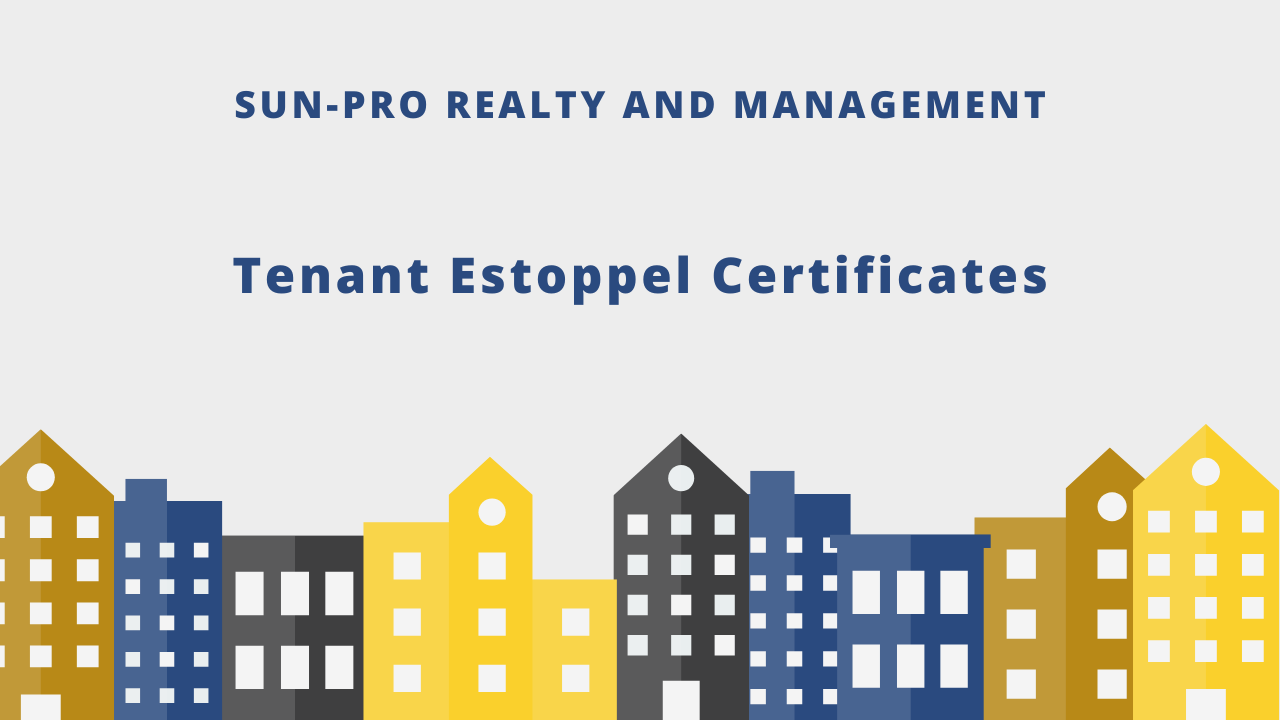
Key Takeaways
- Protect Your Investment: A tenant estoppel certificate prevents future disputes and confirms lease terms.
- Streamline Transactions: It helps ensure accurate lease details for financing and smooth property transfers.
- Get Expert Guidance: Working with professionals like Sun-Pro Realty and Management makes the process easier and more secure.
A tenant estoppel certificate is one of the most crucial documents for any real estate investor buying a rental property with existing tenants. Skipping this step can lead to costly disputes or unexpected obligations after closing.
So, what exactly is a tenant estoppel certificate, and why is it essential when purchasing a property with tenants? In this post, Sun-Pro Realty and Management will break down everything you need to know about estoppel certificates and provide guidance on getting tenants to sign them correctly.
Keep reading to learn more!
What Is a Tenant Estoppel Certificate?
A tenant estoppel certificate is a legal document in which a tenant verifies the key terms of their lease, such as rent amount, lease start and end dates, and any other obligations, for a third party like a buyer or lender. By signing it, the tenant confirms these details and prevents themselves from making conflicting claims later, based on the legal principle of “estoppel.”
This document is a critical part of due diligence when purchasing an income property. It allows investors to answer an essential question: “Have the lease terms been altered in any way since the lease was originally executed?” Importantly, an estoppel certificate confirms the lease terms but does not change them.
For lenders, estoppel certificates are often required to evaluate a property’s cash flow before issuing financing. For savvy investors, obtaining this document is essential to protect your investment and ensure there are no hidden surprises with tenant agreements.
.jpg)
Why Tenant Estoppel Certificates Matter for Property Investors
A tenant estoppel certificate helps you in the following when negotiating to buy a tenant-occupied rental property.
- It verifies the lease terms: They provide a snapshot of the lease terms from a reliable source. Although sellers will provide information on the details of the lease, estoppel certificates allow tenants to directly confirm or refute those details.
- Uncovers existing problems: A tenant estoppel certificate reveals lingering issues with the tenants that the seller may have failed to disclose. Buyers and lenders can gain full assurance of the accuracy of the lease and the absence of hidden claims or defaults.
- Aids in due diligence: A tenant estoppel certificate partly serves as proof of income when applying for a mortgage. It allows for more precise estimates of the projected future returns. Lenders use this document to properly appraise the market value of a rental property.
- Simplifies and speeds up transactions: While buyers require estoppel certificates to complete their purchase, lenders require them before issuing a loan. In both cases, by proving the property’s financial stability, tenant estoppel certificates help to facilitate the transaction.
- Prevents legal difficulties: By getting tenants to sign an estoppel certificate, property investors protect themselves from potential disputes with tenants. The tenants in the property cannot make future claims that contradict the information contained in the estoppel certificate.

What Should a Tenant Estoppel Certificate Contain?
The usual contents of a tenant estoppel certificate are:
- A description of the property: This includes the type of property, its address, a description of the areas leased by the tenant, and other relevant details.
- Details of the lease: Information on whether the lease is still in full force, confirmation that the tenant named in the original lease is the same person occupying the property, and the lease start & end dates.
- Lease amendments, modifications, etc.: If the original lease has been amended or modified, this will be included, along with details of lease renewals.
- Rents and other payments: The rent amount and rent due dates, plus the amount of the security deposit and information on how it is held, plus details of rent that has been paid in advance or rent defaults.
- Tenants' rights: If the tenant has been granted any rights by the lease agreement, such as the right to renew, extend, or terminate the lease, this should be stated in the details of the estoppel certificate.
- Outstanding claims by the tenant: All existing claims against the landlord must be included in the document. An estoppel certificate gives the tenant the opportunity to explain those claims.
This is by no means a comprehensive list of what can and should be included in a tenant estoppel certificate. For a fuller explanation of what the document must contain, please talk to an experienced real estate lawyer.
Tenant Estoppel Certificates: What to Expect
When asked to sign an estoppel certificate, it is normal for most tenants to feel a bit suspicious or even show reluctance to sign the document. Here is what to expect when trying to obtain an estoppel certificate for a tenant-occupied property:
- Tenants will want to compare it to their lease: It is a good sign when tenants highlight inconsistencies between their lease and the estoppel document. It shows that the tenant is paying attention to the details and trying to ensure the accuracy of the document.
- Tenants may involve their lawyer: Most tenants, if they consent to sign the document, will do it without the help of a lawyer. But some tenants will want a lawyer to review the estoppel. This is usually the case with high-value leases or when there are complex clauses in the lease.

But what are your options if a tenant refuses to sign the estoppel?
- The estoppel is still binding: If a tenant refuses to sign the estoppel, their landlord will sign on their behalf. In that case, the law assumes that the tenant has automatically accepted the terms of the estoppel as accurate and will be bound by its content.
- Add it as a clause in the REPC: When making your initial offer for the property, include an estoppel certificate as one of the clauses in the Real Estate Purchase Contract. If you did not do this, make sure to add it when making a counteroffer.
Finally, you can usually get a tenant to sign the estoppel document if you help them understand how the document protects them from arbitrary changes of the lease terms and rent by the new owner.
Bottom Line
Obtaining a tenant estoppel certificate is a crucial step when purchasing a rental property with existing tenants. It protects you from unexpected disputes, ensures lease terms are accurately represented, and helps streamline both financing and the purchase process.
By understanding what an estoppel certificate is, what it should include, and how to guide tenants through signing it, you can safeguard your investment and move forward with confidence.
Sun-Pro Realty and Management can help you navigate this process smoothly, ensuring you have all the tools and knowledge needed to make a smart, secure rental property purchase.
